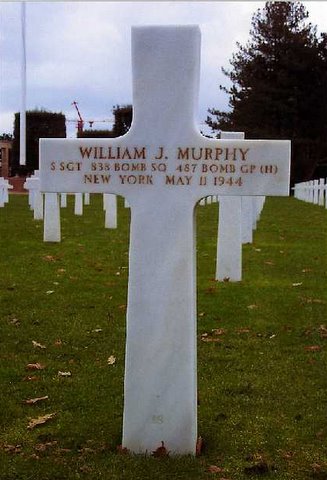William James Murphy was born in New York on January 20, 1920, probably on his family's farm at Marcellus, Onondaga County, New York. He was one of at least six children of James Leon Murphy (often called Leon) (24 May 1892 19 Jul 1970), who was born at Otisco, Onondaga County, New York; and Charlotte M. (Dye) Murphy (24 Sep 1894 22 Nov 1982), who was born at Marcellus, Onondaga County, New York. His parents married about 1915. In January 1920 the family residence was a farm at Marcellus, Onondaga County, New York. By June 1925 the family lived at 52 Green Street, Seneca Falls, Seneca County, New York, where his father was employed bottling milk. In April 1930 the family was still in Seneca Falls, and his father was a foreman for Seneca Falls Baking Company. In April 1935 the family lived at Stanley, Ontario County, New York. By April 1940 the family lived on a farm at Skaneateles, Onondaga County, New York, and his father was a farmer. William Murphy's home of record was 4 Hannum Street, Skaneateles, New York. In November 1944 his family moved to 20 East Lake Street, Skaneateles, New York.
He completed three years of high school and worked as a meat cutter. He was single, without dependents, when he enlisted in the U.S. Army Air Corps at Syracuse, New York on December 9, 1941. He was 5 feet 9 1/2 inches tall, and weighed 154 pounds. He had blue eyes and brown hair, and wore size 12D shoes.
From December 1941 to January 1942, he was assigned to Sheppard Field at Wichita Falls, Texas, where he was processed and completed basic training. From February 1942 to April 1943, he was assigned to Miami, Florida (duties unknown). From April to June 1943 he was assigned to Laredo, Texas, where he probably completed Army Air Forces aerial gunnery training. In July 1943 he returned to Miami, Florida, where he probably served in one of the Antisubmarine Squadrons of the 26th Antisubmarine Wing. This Wing dispatched B-24 antisubmarine patrols from bases in Florida, Cuba, Puerto Rico, Trinidad, British Guyana, Suriname, Brazil, and Ascension Island.
In November 1943 S/Sgt Murphy was assigned to the 487th Bomb Group at Bruning Army Air Field, Nebraska. In December 1943 he moved with the 487th Bomb Group to Alamogordo Army Air Base, New Mexico, and was assigned to the heavy bomber crew of Lt Edward J. Brodsky in the 838th Bomb Squadron of the Group. S/Sgt Murphy was a rated flight engineer and aerial gunner at that time. The Brodsky crew completed B-24 combat crew training at Alamogordo, and deployed with the 487th Bomb Group to England in MarchApril 1944. The crew flew B-24H 42-52581 overseas via the southern Atlantic ferry route, and arrived in England by mid-April 1944. The 487th Bomb Group was based at Army Air Forces Station 137 near the village of Lavenham, Suffolk, England, and was part of the 8th U.S. Army Air Force in Europe.
On May 11, 1944 S/Sgt Murphy flew with then Captain Edward J. Brodsky's lead crew in B-24H 42-52763, in the deputy lead position of the 838th Bomb Squadron.
The target for this mission was the railroad marshalling yards at Chaumont, France. However, a navigation error resulted in the Squadron flying over accurate German flak guns at Chateaudun, France. Brodsky's plane was hit by flak in the number three engine, which caught fire. The aircraft peeled off to the right. After losing the number four engine it dove down, and Capt Brodsky successfully crash landed the aircraft on farmland belonging to a Mr. Hubert Bourjois near the village of Gaubert, commune of Guillonville, France, about fifteen miles east of Chateaudun. One crew member, Lt Lee G. Johnson, bailed out safely before the landing. Capt Brodsky and his copilot, Capt John W. Roberts, escaped from the aircraft on the ground, but were unable to suppress a wing fire. S/Sgt Murphy and five of his crew mates were trapped in the aircraft and died when the fire spread and the fuel tanks exploded, engulfing the aircraft in flames.
On May 16, 1944 five of the dead, including S/Sgt Murphy, were buried as unknowns at the Saint Cheron Communal Cemetery in Chartres, Eure et Loir, France, and were not identified until after the war. The remains of S/Sgt Lipskas were never found. S/Sgt Tollett was thrown from the plane during the landing, and suffered a severe head injury; he died at a German Air Force Hospital in Orleans, France on May 12, 1944, and was buried at the Memorial Cemetery in Orleans, France. After the war, a search failed to identify his remains. Lipskas and Tollett are still listed as missing in action.
In March 1947 S/Sgt Murphy's remains were exhumed and moved to the U.S. Military Cemetery Blosville, France (near Carentan), where they were examined. His remains were reinterred at Blosville in May 1947. In December 1947 the identity of his remains was officially confirmed. In June 1949 his remains were permanently reinterred at the Normandy American Cemetery, France.
B-24H 42-52763 crew:
Brodsky, Edward J Capt Pilot POW
Roberts, John W Capt Copilot POW
Weiss, Lester 1/Lt Navigator KIA
Johnson, Lee G 2/Lt Navigator POW
Pearce, Thomas W 1/Lt Bombardier KIA
Simoni, Walter T/Sgt Engineer KIA
Nance, Clifford P T/Sgt Radio Operator KIA
Tollett, Elton S/Sgt Ball Turret Gunner MIA
Lipskas, Bronis D S/Sgt Tail Gunner MIA
Murphy, William J S/Sgt Top Turret Gunner KIA
Source of information: Paul M. Webber, www.findagrave.com

